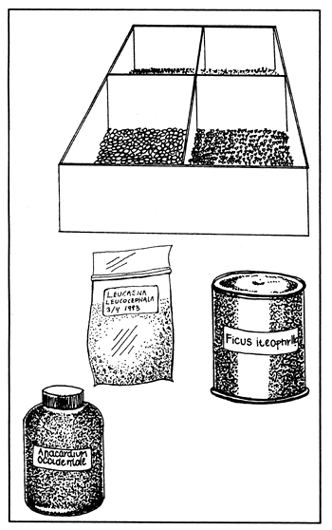Under ordinary room conditions (= open storage), viability of many seeds is reduced by half within 6 months.
To store seeds, follow this simple procedure step-by-step:
Store only new, mature, healthy and well-dried seeds.
Keep them in dry and cool place to extend their viability.
Seeds easily re-absorb moisture. To maintain dryness, keep seeds in air-tight containers like tin cans or glass jars with tight fitting lids.
Put in some moisture absorbing material. Dry wood ash, dry charcoal, powdered milk, toasted (cooled) rice, or small pieces of newspaper are all good. The drying material should take up about one-fourth of the container space.
Label the containers with the type of seed, place, and date of collection.
If possible, include the initial percent viability of the seeds. To do this, plant some seed to see how many germinate. If 8 of 10 germinate, for example, percent viability is 80%. This information will help you to learn about how much each type of seed loses viability between collection and planting.
Protect seeds from insects and fungi. Before storing in containers, mix with dry ash, powdered seeds of black pepper or neem leaves. Or use extract of neem, peanut, castor bean, or cotton: 1 teaspoon oil/1 kg seed. Or use naphthalene balls: 1 or 2 pieces/10 kg seed.
Protect from rodents and birds during storage.
For good seed storage, always use sealed containers.
After seed has been dried properly, store it in tin cans, metal boxes, glass jars, or plastic bags or container with lids that can be sealed (Figure 25).
| Points to remember when using sealed containers: |  |
| |
| Some species have seeds which do not tolerate drying or cold temperatures. Examples of these are rambutan, durian, mangosteen, mango, jackfruit, avocado, rubber, cacao, mahogany, and neem. They can only be stored from several days, up to a few months under ordinary room conditions. It is best, therefore, to plant these kinds soon after collection. But if they must be stored: | |
| |
| Figure 25 Seed storage containers: metal box, tincan, plastic or glass jar. |
The length of time for seed storability of some species is given in Appendix I.